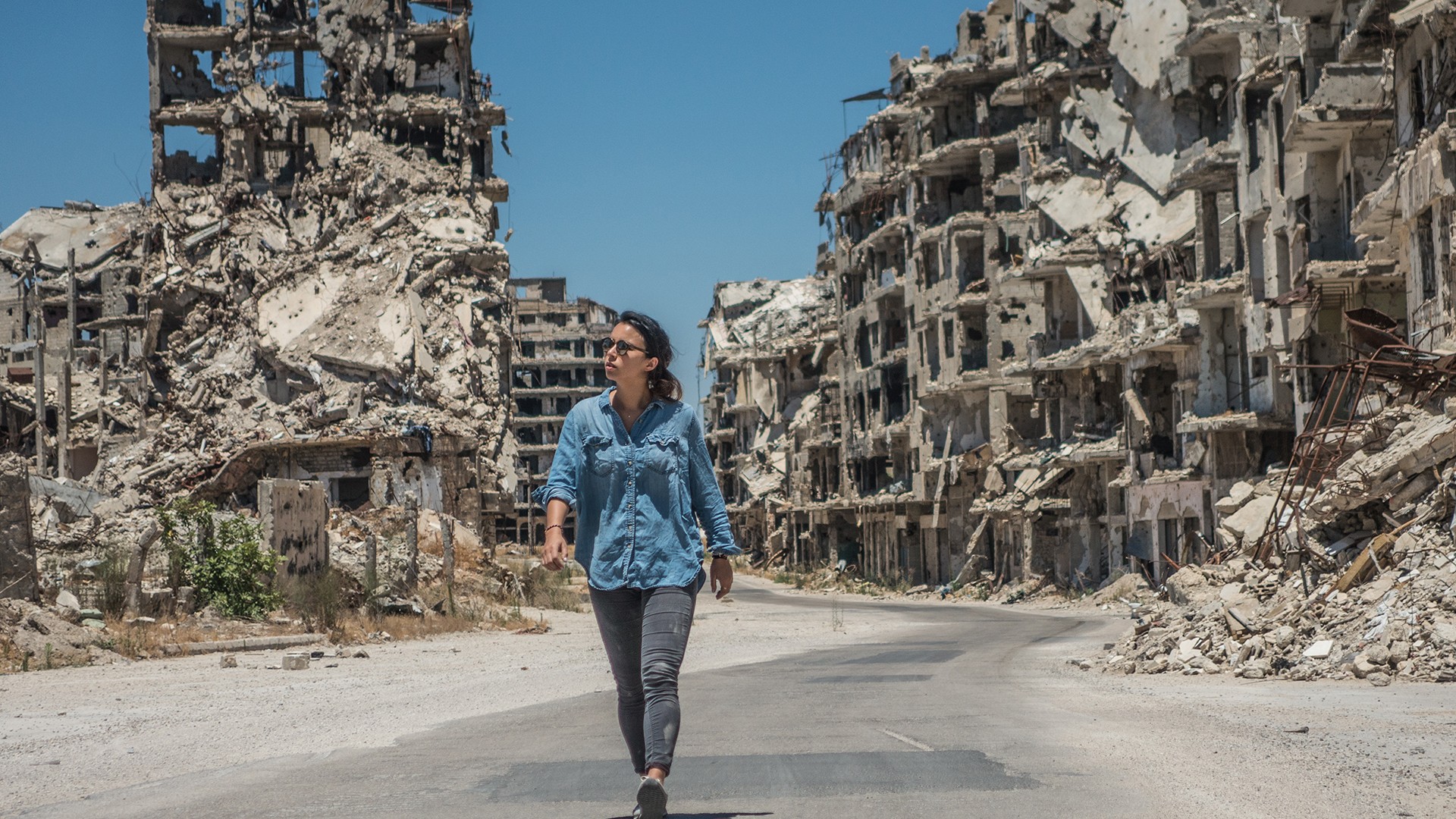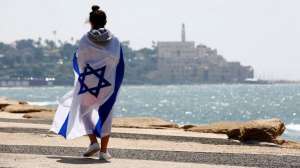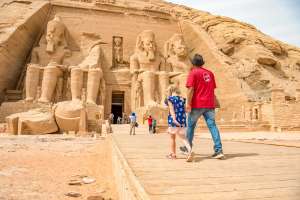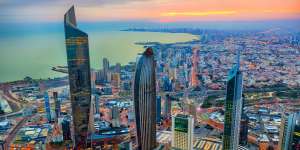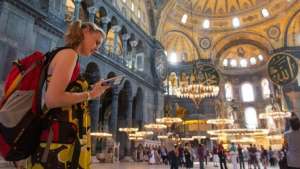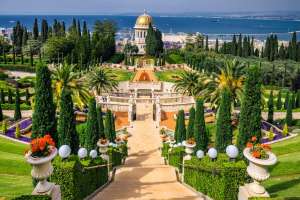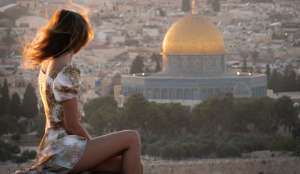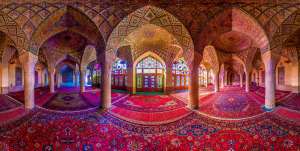For centuries, Syria stood as one of the most culturally rich and historically layered civilizations in the Middle East. From the ancient ruins of Palmyra to the bustling markets of Aleppo and Damascus, the country carried the weight of countless empires and faiths that had shaped its soil. But in the last decade, this same land — once alive with trade, learning, and art — became synonymous with devastation and human loss. The civil war in Syria has not only taken more than 130,000 lives but also obliterated its heritage, its identity, and its very soul.
What began as a hopeful echo of the Arab Spring — a movement that once promised democracy and reform — quickly descended into one of the most brutal wars of the 21st century. As uprisings spread across the Middle East and North Africa in 2011, ordinary Syrians, inspired by what they saw in Tunisia and Egypt, began to take to the streets. In the southwestern city of Deraa, peaceful demonstrators gathered to demand change — calls for justice, freedom, and dignity that would soon be met with unimaginable violence.
At that time, there was a fragile glimmer of belief that Bashar al-Assad, who had ruled Syria since 2000, might turn away from the iron-fisted legacy of his father, Hafez al-Assad. Many believed he would embrace reform and modernization, offering new hope to Syria’s younger generations. But that illusion shattered when government forces answered unarmed protests with bullets instead of dialogue. The movement that started with chants and banners turned, almost overnight, into an all-consuming war.
The Descent into Chaos
The demonstrations in Deraa spread rapidly to other parts of the country, growing louder and more defiant. Instead of restraint, the Assad regime responded with heavy weaponry, mass arrests, and fear campaigns. As the situation spiraled, foreign powers began to circle, each pursuing their own interests.
Russia and Iran stepped in to ensure Assad’s grip on power would not be broken. Their involvement transformed the conflict into a proxy battleground, entangling Syria in global politics. Meanwhile, the United States hesitated, offering inconsistent support to rebel groups while stopping short of real intervention.

On the ground, the situation became impossibly complex. Iran-backed militias from Lebanon, Iraq, and Yemen joined Assad’s forces, while Kurdish fighters in the north seized the chaos as a chance to push for autonomy. Extremist groups, taking advantage of the power vacuum, poured in from across the region, turning Syria into a patchwork of warring factions. Turkey entered the conflict to counter Kurdish influence, and Gulf nations such as Saudi Arabia funneled money and weapons to various rebel groups in an attempt to destabilize Assad’s rule.
The result was a tangled web of destruction. The Syrian army, aided by its allies, unleashed bombardments on cities, targeting hospitals and residential areas. Torture became a political weapon. Even chemical attacks — weapons of absolute horror — were deployed against civilians. The world watched as red lines were crossed again and again, and yet meaningful action never came. Years of unrelenting shelling, airstrikes, and sieges followed, leaving entire cities reduced to ashes.
By the time the fighting slowed, hundreds of thousands were dead — men, women, and children — and millions displaced. About 22,000 of the victims were children, their lives cut short in a conflict they never chose. The war ended not with victory or reconciliation but with exhaustion. Assad remained in power, clinging to a nation in ruins, largely because those with the most firepower were the ones willing to commit atrocities to ensure survival.
The Human and Cultural Cost
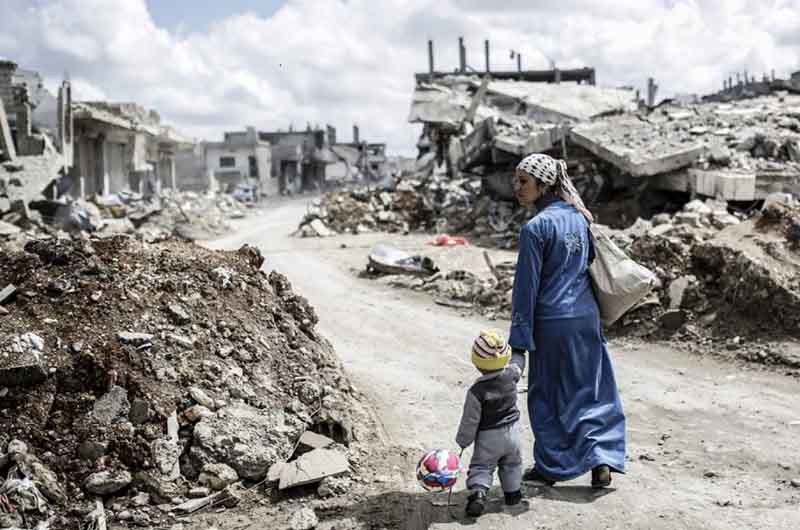
Today’s Syria is a country that bears scars both visible and unseen. More than half of the nation’s pre-war population — roughly 22 million people — has been forced from their homes. Around six million Syrians now live as refugees in neighboring countries, with Turkey, Lebanon, and Jordan carrying the heaviest humanitarian burden.
Those unable to flee have endured years of fear and deprivation. Thousands have perished in government prisons, while tens of thousands more remain missing, their fates unknown. The United Nations Human Rights Council continues to document grave abuses, from mass detentions to torture and extrajudicial killings. For the survivors, the psychological trauma is overwhelming — generations living with invisible wounds that may take decades to heal.
Economically, Syria has collapsed. More than 70 percent of its population now lives below the poverty line. Before the war, 47 Syrian pounds equaled one U.S. dollar; today, it takes more than 1,200. Inflation has crushed livelihoods, leaving families unable to afford basic necessities. The International Committee of the Red Cross reports that nearly a third of Syrian women have no source of income, while 80 percent of young people struggle just to find enough food for the day.
The future of Syria’s children paints an equally grim picture. A 2017 International Rescue Committee report revealed that one-third of Syrian children are not attending school. Those who do often face enormous gaps in education — many middle school students cannot read or solve basic arithmetic problems. The war has effectively robbed an entire generation of both safety and opportunity.
Meanwhile, the physical destruction is staggering. Cities like Aleppo, Homs, and Raqqa lie buried beneath millions of tons of rubble. Roads, bridges, schools, and hospitals have been decimated. What was once one of the Middle East’s most advanced healthcare systems now barely functions. Rebuilding these structures will take decades — and billions of dollars — that the country simply does not have.
And through it all, Bashar al-Assad remains in power, a symbol of a conflict that reshaped not only Syria but the geopolitical balance of the entire region.
Before and After: Aleppo’s Lost Heritage
The scars of war are carved into every corner of Aleppo, once one of the world’s oldest continuously inhabited cities. Known for its vibrant souks, majestic citadel, and centuries-old mosques, Aleppo stood as the cultural and commercial heart of Syria. It was a city where traders from every corner of the ancient world met — where history itself seemed to live and breathe through narrow alleys filled with the scent of spices and the echo of the call to prayer.
But after years of bombardment and relentless fighting, much of Aleppo now lies in ruins. What once defined Syrian culture — its architecture, its artistry, its sense of continuity — has been buried beneath mountains of debris. Entire neighborhoods that had survived the Crusades, the Ottoman era, and the French Mandate crumbled in a matter of months under artillery and airstrikes.
28 Before-and-After Photographs That Tell the Story
The Olympia Restaurant, a local landmark in Aleppo, undertook an emotional project to document this transformation. It published a haunting collection of images showing Aleppo’s most familiar streets and monuments — before the war, and after. The result is a visual record of heartbreak: an unflinching look at what happens when centuries of civilization collide with the machinery of modern war.
Many of the locations shown were once part of UNESCO’s World Heritage Sites. They included mosques with elaborately carved minarets, medieval caravanserais that had hosted merchants for hundreds of years, and entire residential quarters built from the same pale stone that gave Aleppo its timeless beauty. Looting, arson, and indiscriminate shelling have reduced many of these places to rubble.


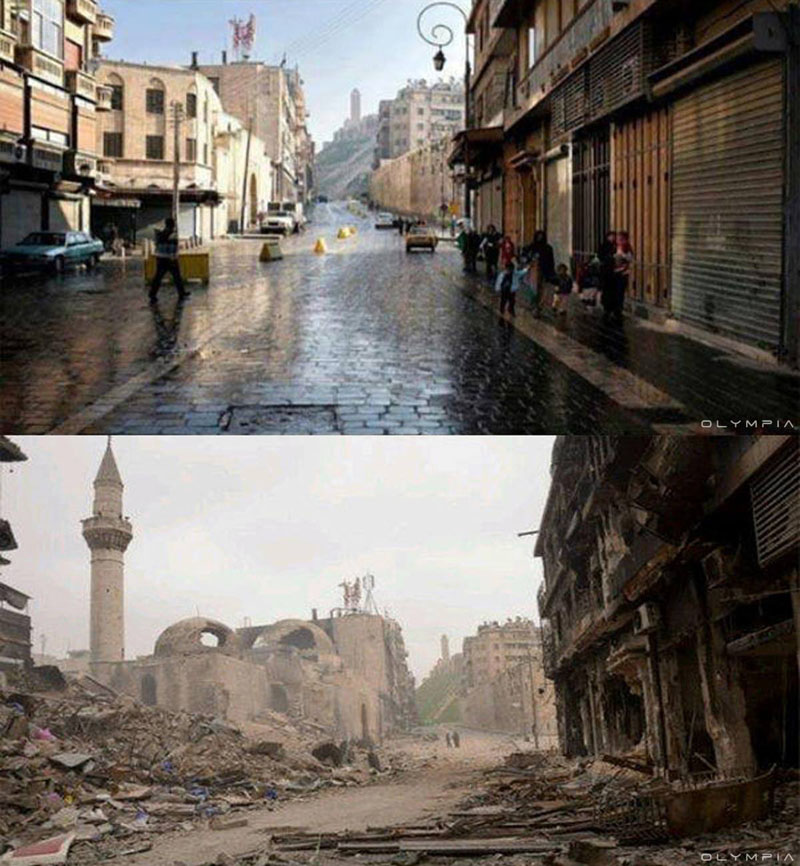

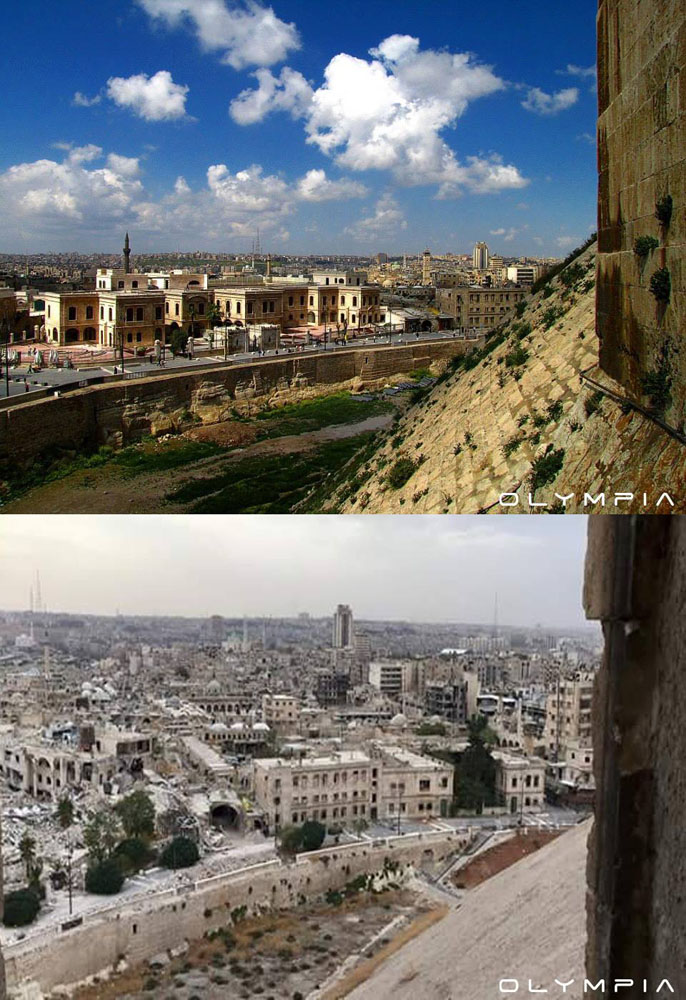
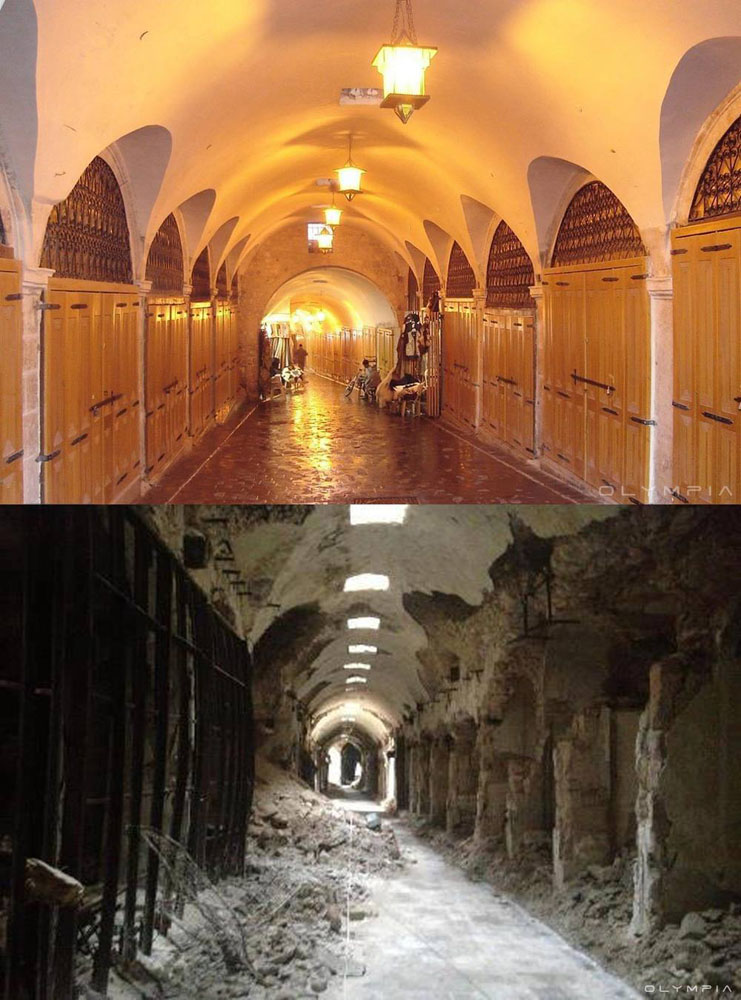
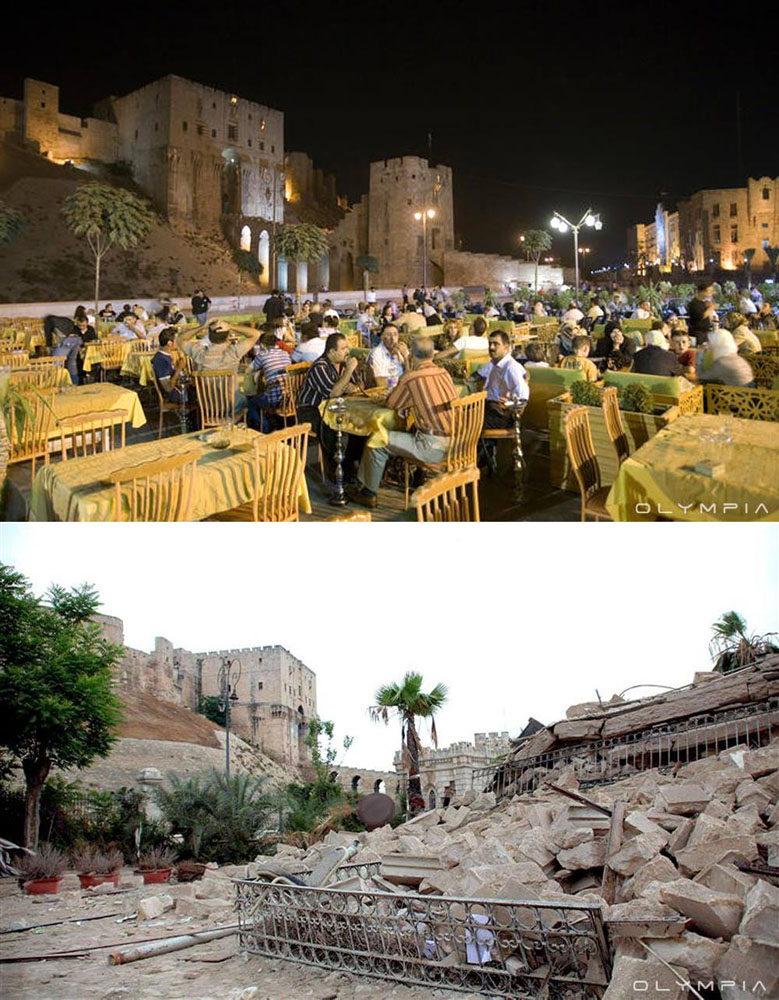
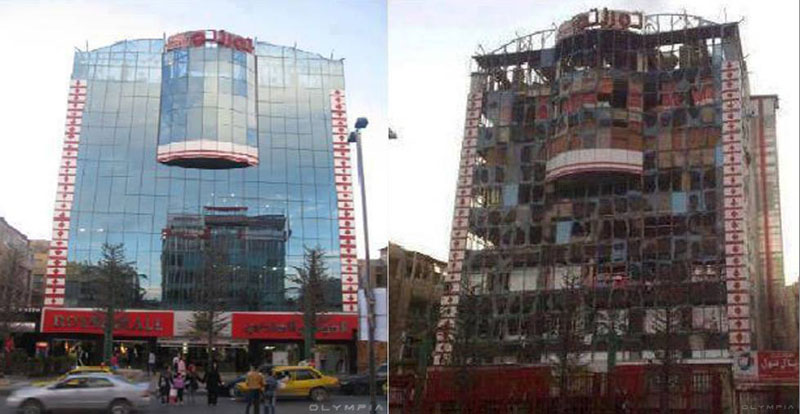



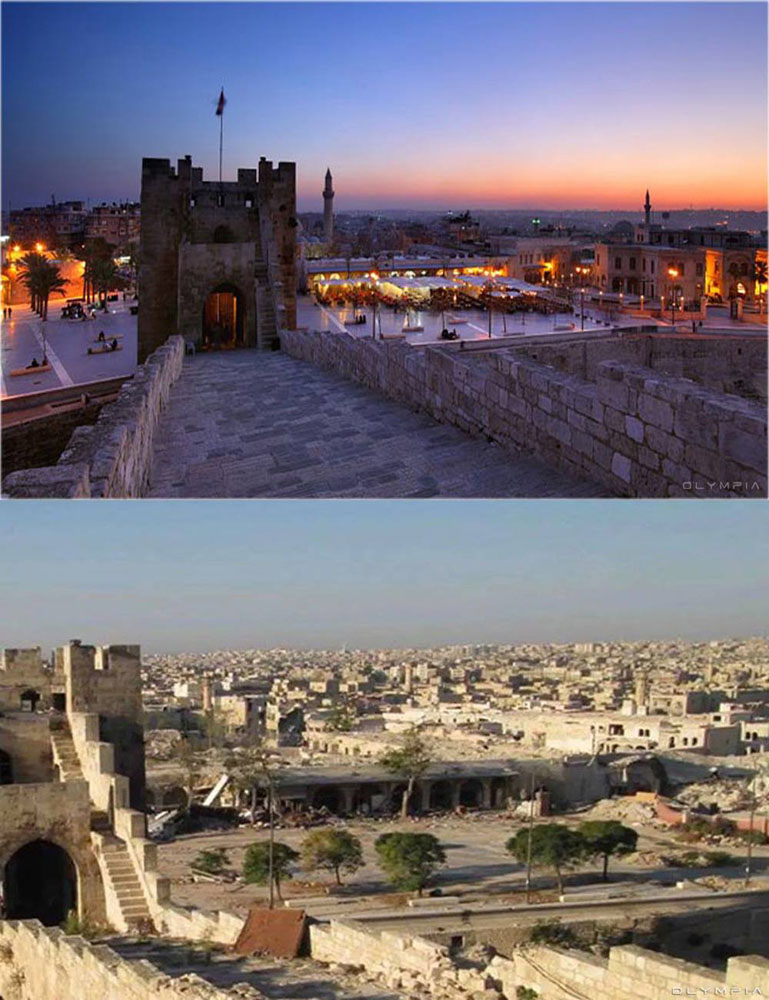

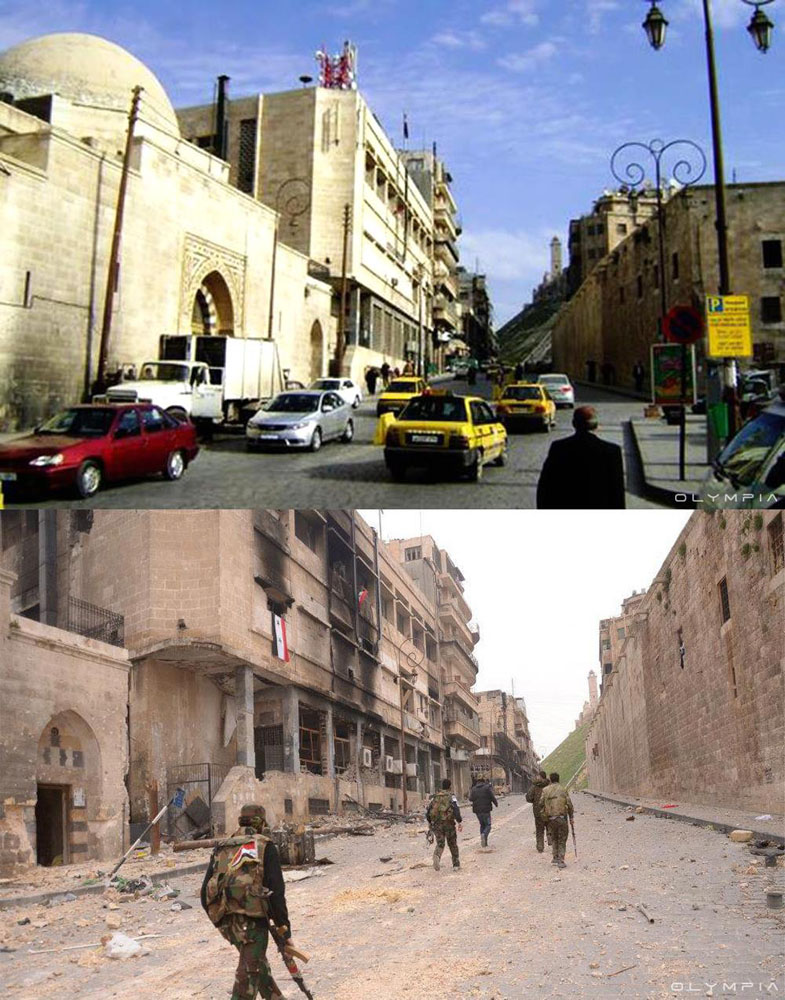
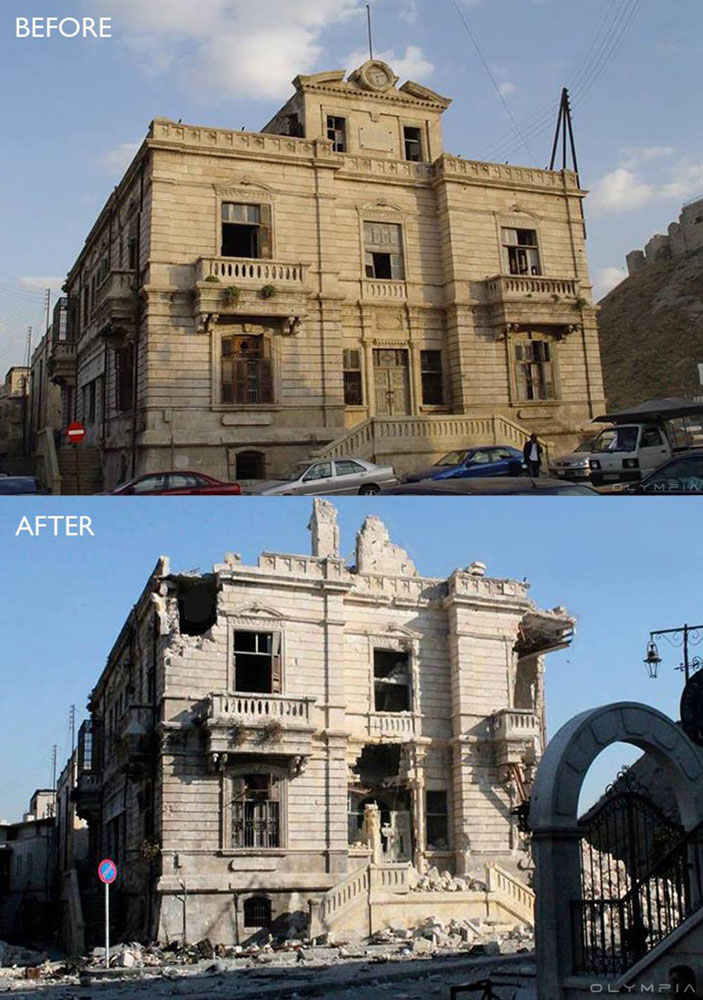
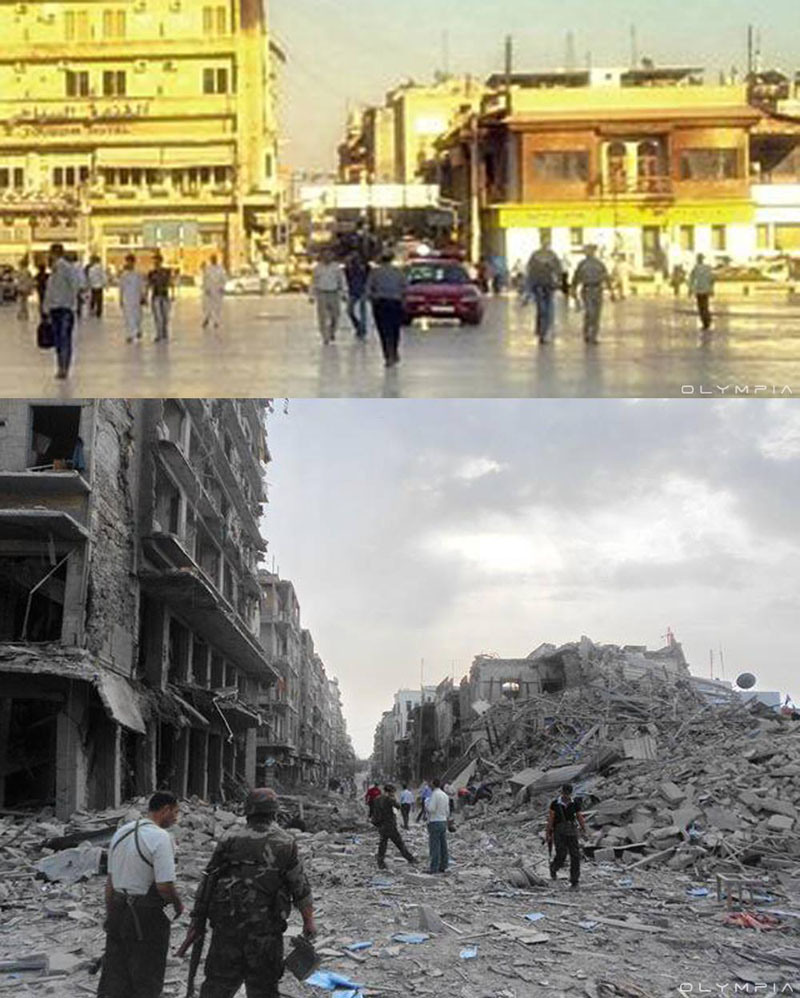
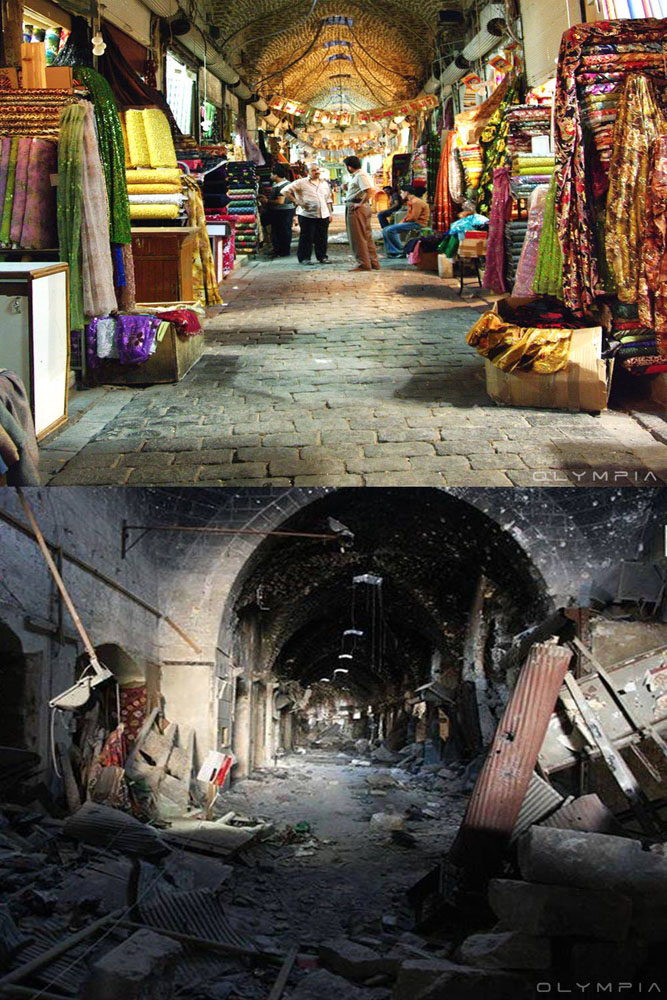

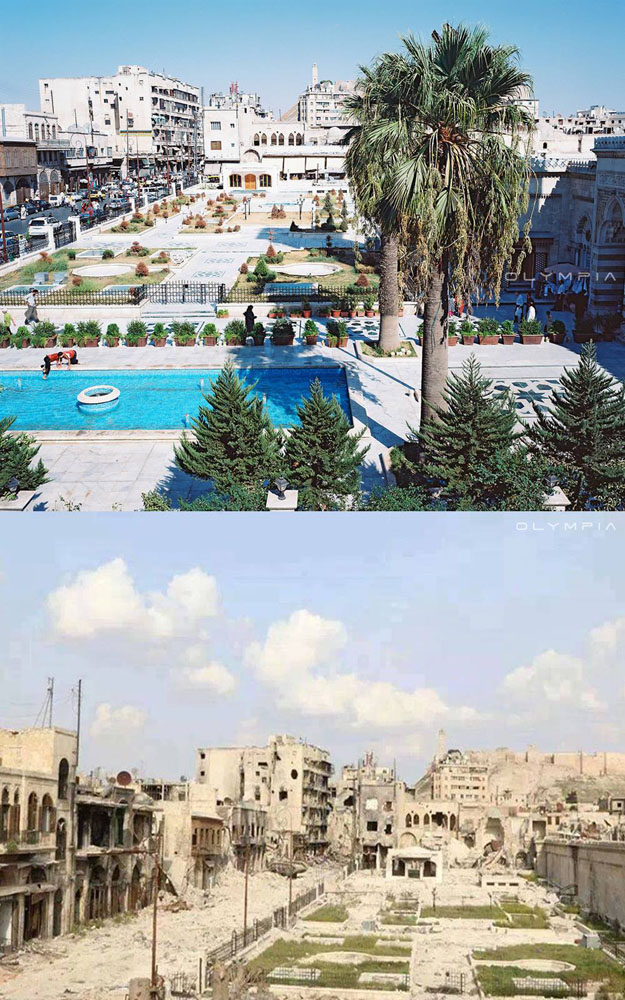
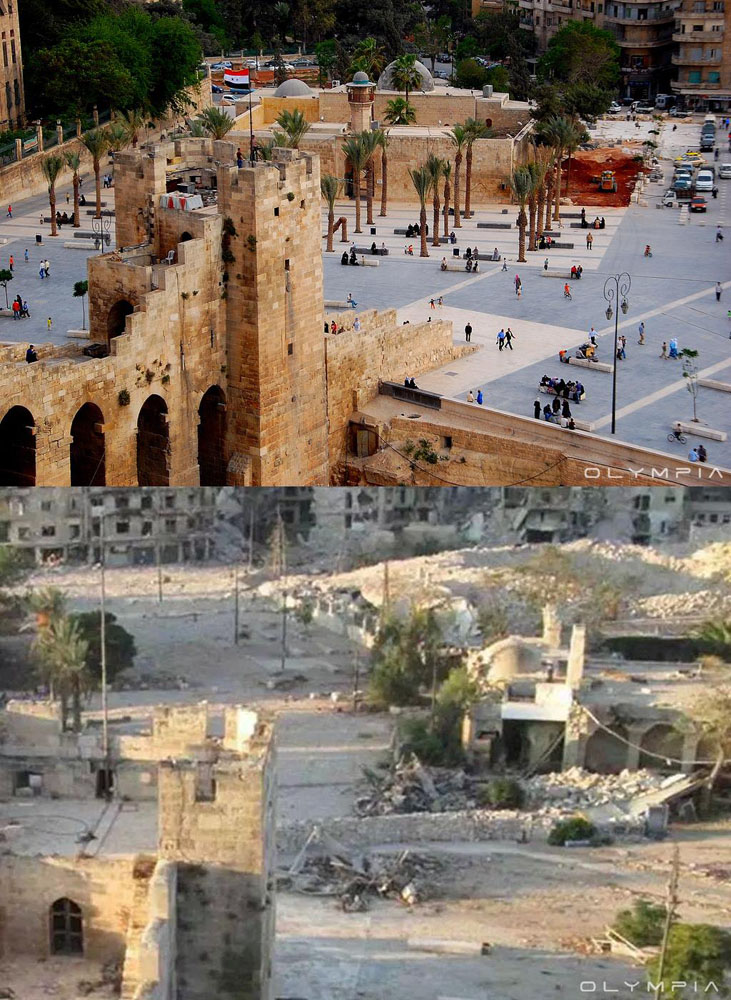
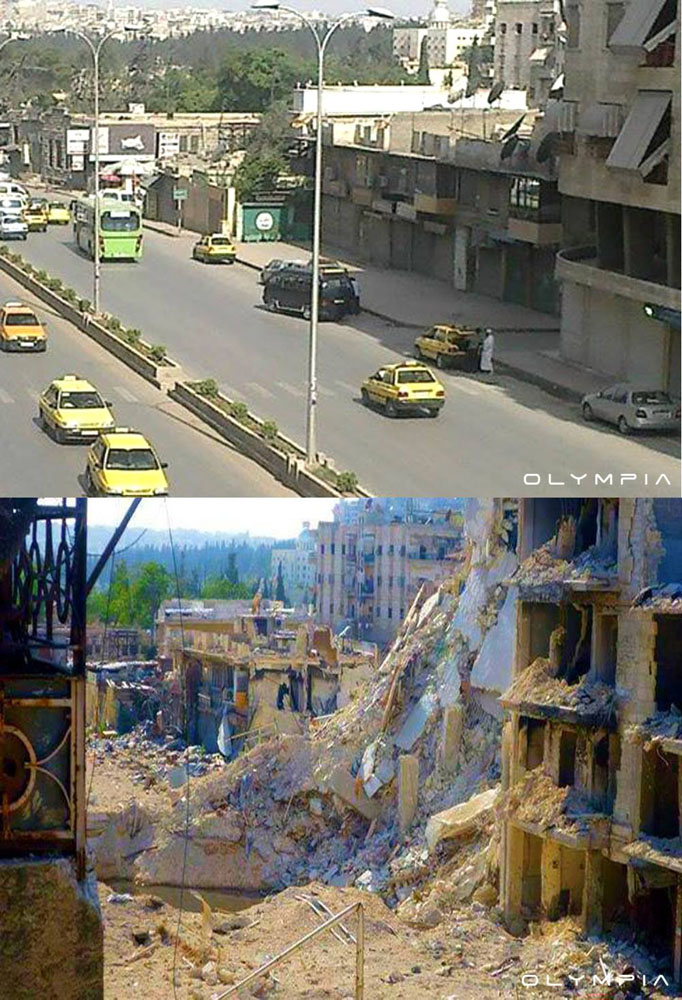
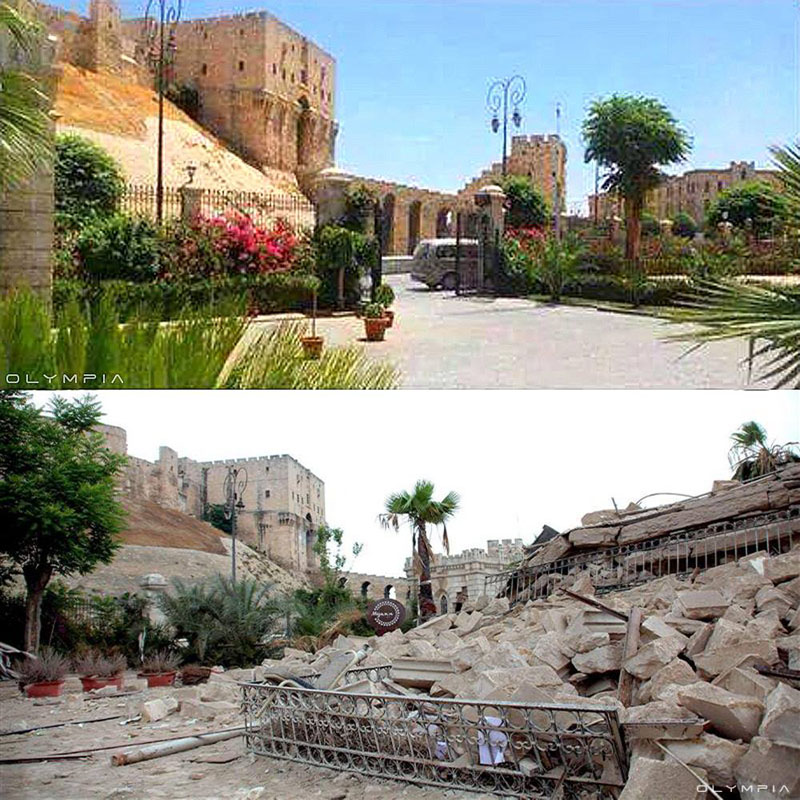
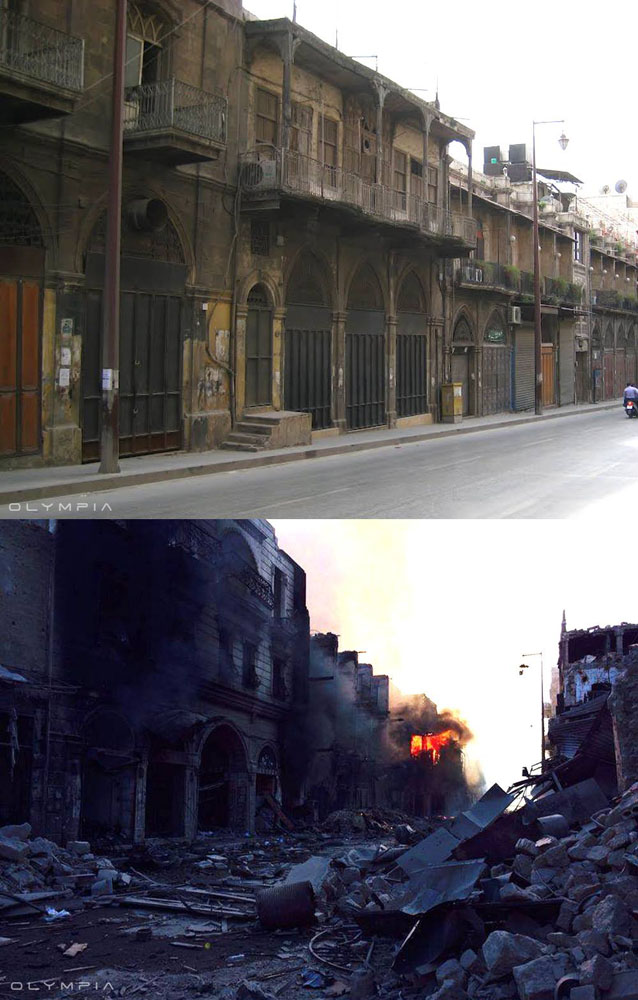

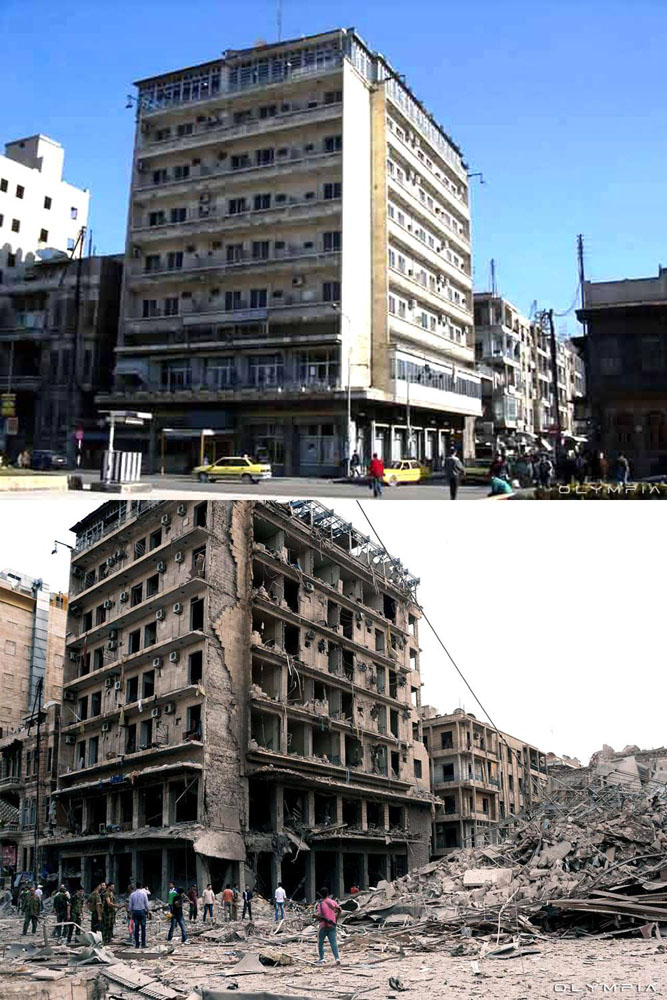
Each photo comparison speaks for itself. Streets once filled with life now resemble skeletal remains of stone and dust. Marketplaces where traders once shouted and children played are now unrecognizable wastelands. The Grand Mosque of Aleppo, one of the city’s most iconic landmarks, lost its minaret — a tower that had watched over the city since the 11th century. It collapsed during fighting in 2013, symbolizing the fall of Aleppo’s spirit.
Residential areas that once showcased intricate Arab and Ottoman architecture have been reduced to broken walls and hollow doorways. These are not just the remnants of buildings; they are the ruins of memory. Every photograph tells a story of a family, a generation, a piece of Syria’s collective identity wiped away.
Even now, years after major fighting subsided, the work of restoration moves slowly. UNESCO and local preservationists are attempting to save what remains, but the challenges are enormous. The rebuilding of Aleppo — both its structures and its soul — will take not years, but decades.
The Forgotten People Behind the Ruins
While the photographs of Aleppo’s destruction are haunting, they are only part of Syria’s story. Behind each ruined building are lives forever changed. Former merchants now live as refugees in tented camps across the Turkish border. Teachers, doctors, and students who once walked those streets now struggle to survive abroad, scattered across continents.
Those who remain in the country live among the debris, trying to reconstruct normalcy from chaos. Markets have reopened amid the rubble, and children attend makeshift schools inside damaged buildings. Despite everything, life continues — fragile, persistent, and defiant.
Syria’s story after the war is not just one of loss; it is also about endurance. The people who stayed behind, or who plan to return, represent the beating heart of a nation that refuses to disappear. For them, every repaired wall, every reopened shop, every rebuilt classroom is an act of resistance against oblivion.
A Nation Waiting to Rise Again
The war in Syria left behind a fractured nation, but not a lifeless one. Across the country, local initiatives have emerged to clean streets, restore monuments, and provide education for children who lost years of schooling. Artists have begun painting murals on bombed-out buildings, turning grief into expression. In some neighborhoods, communal kitchens feed hundreds daily — gestures of humanity rising from the ruins of war.
International organizations and a few foreign governments have pledged reconstruction aid, but the political complexities make it slow and uncertain. Sanctions, corruption, and lingering distrust still paralyze recovery efforts. Yet despite the obstacles, small sparks of renewal appear everywhere — in the resilience of displaced Syrians returning home, in the rebuilding of Aleppo’s ancient souk, and in the quiet determination of ordinary citizens who simply want peace.
The Legacy of a Lost Generation
Perhaps the greatest cost of all is invisible — the loss of potential. Millions of Syrian children grew up knowing only war. Their future depends on whether the world chooses to remember them or forget. Education, mental health support, and social reintegration will be critical to healing this generation.
Those who once lived in Syria’s thriving cities remember not only the pain but also the beauty that came before it — the lively cafés of Damascus, the shimmering minarets of Hama, the fragrance of Aleppo soap and jasmine in summer air. These memories survive in stories told across refugee camps and distant countries, keeping the idea of Syria alive in hearts even when its cities are gone.
Syria today stands at a crossroads between despair and revival. The war has ended, but its consequences endure. The land that once nurtured poets, scholars, and merchants must now rebuild not only its walls but also its humanity. And perhaps, in the quiet persistence of its people, lies the faint promise that Syria — though wounded — will rise again.


